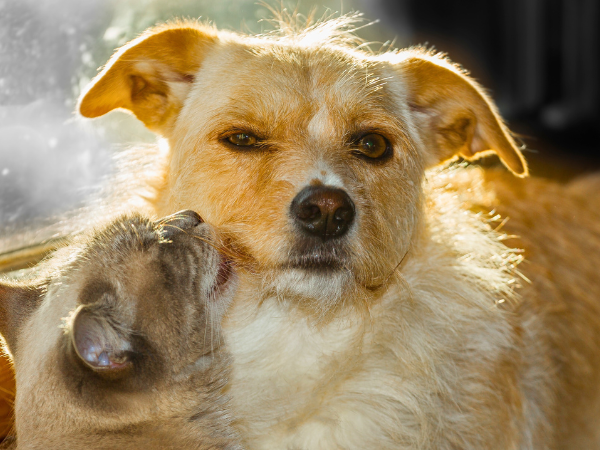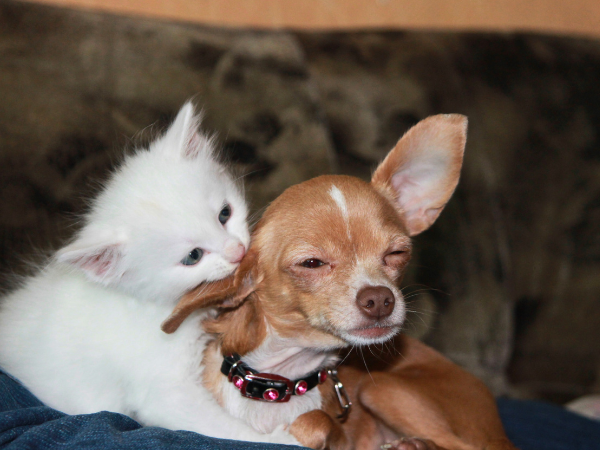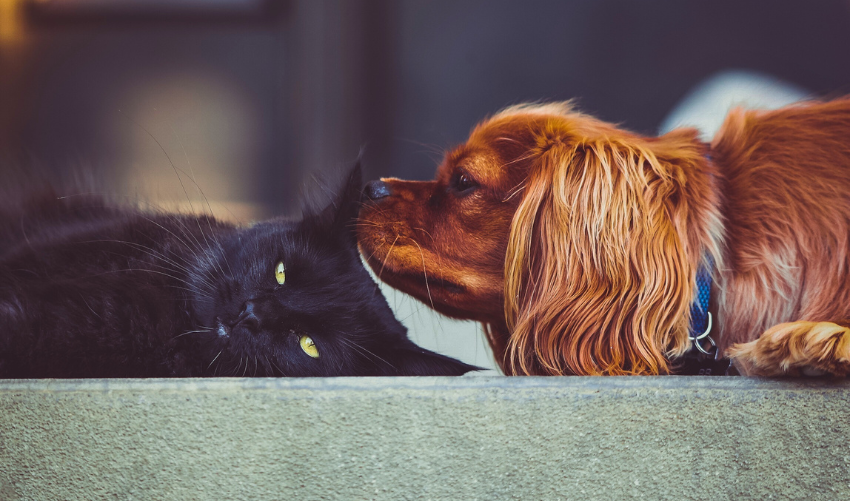Cats and dogs can live together happily. However, the introduction process is vital. It sets the tone for their future relationship.
This guide will provide tips for a smooth introduction. You will learn steps to take, signs to watch for, and how to ensure both pets feel safe. A little preparation can lead to lasting friendship.
Understanding The Importance Of A Calm Introduction
A calm introduction is vital for their future relationship. Stress and anxiety can arise from sudden meetings. This section will explore why first impressions matter and how to recognize stress signals in both pets.
Why First Impressions Matter
Cats and dogs form early opinions based on initial experiences, which can affect long-term relationships. A calm atmosphere helps pets feel safe. Here are some key points to consider:
- Initial meetings are crucial.
- A relaxed environment promotes better feelings.
- Negative experiences can lead to fear.
- First impressions shape future behaviors.
Pets may remember their first encounter for a long time. This memory can influence their behavior. If the meeting is stressful, one or both pets may react poorly in the future. A few tips for a calm introduction:
- Choose a quiet space for the introduction.
- Use barriers, like gates, for safety.
- Allow pets to observe each other from a distance.
- Offer treats to create positive associations.
By ensuring a calm introduction, you increase the chance of a lasting friendship.
Recognizing Stress Signals In Cats And Dogs
Recognizing stress signals is crucial during the introduction process. Signs like growling, hissing, barking, or freezing indicate fear or discomfort and require immediate attention. Here are common signs to watch for:
| Animal | Stress Signals |
|---|---|
| Cats |
|
| Dogs |
|
Pay close attention to your pets’ body language. If you notice any stress signals, separate them immediately. Give each pet time to calm down.

Preparing Your Home For The First Meeting
Preparing your home helps create a safe environment. This reduces stress for both pets. A calm introduction can lead to a friendly relationship. Start by organizing your home to support both animals.
Creating Separate Safe Spaces
Creating separate safe spaces is essential. Each pet needs a place to retreat. This helps them feel secure. Here are some important points:
- Set up individual areas where each pet can retreat and feel secure without being disturbed.
- Use familiar items, like blankets and toys, to comfort them.
- Ensure these spaces are away from each other to prevent anxiety.
Consider using different rooms or corners. Cats often feel safest in higher spaces. Shelves or cat trees can help. Dogs may prefer a cozy corner or a designated bed. Here’s a simple table to help you plan:
| Pet Type | Safe Space Suggestions |
|---|---|
| Cat | Cat tree, shelf, or quiet room |
| Dog | Cozy bed, crate, or quiet corner |
Remember, pets need time to adjust. Allow them to explore their safe spaces. This will make the introduction more comfortable.
Setting Up Barriers And Visual Contact Points
Setting up barriers helps manage the first meeting. Barriers can reduce stress and anxiety. Use baby gates or cracked doors to allow pets to see and smell each other without full contact. Here are some tips:
- Use baby gates to create a visual barrier.
- Keep doors slightly open to let them see each other.
- Monitor their reactions during these initial meetings.
Start with short sessions. Gradually increase the time they spend in sight of each other. This builds familiarity and trust. Watch for signs of comfort or discomfort.
Step-by-step Guide To The Introduction Process
This step-by-step guide will help you introduce them safely and friendly. Follow these steps to create a peaceful environment for both pets.
Letting Them Smell Each Other First
Before any face-to-face meeting, let your pets get familiar with each other’s scents. This helps reduce anxiety. Here’s how to do it:
- Exchange bedding or toys. This allows pets to become familiar with each other’s scent before meeting.
- Keep these items in their own spaces. This will help them feel secure.
- Observe their reactions. Look for signs of curiosity or calmness.
Use a calm voice when talking about the other pet. This creates a positive association. If your dog or cat shows signs of stress, give them space. Patience is key.
Organizing The First Visual Introduction
Once your pets are familiar with each other’s scents, it’s time for a visual introduction. This stage is crucial. Follow these steps:
- Choose a neutral space. A place where neither pet feels territorial works best.
- Use barriers if needed. A baby gate can keep them apart but allow them to see each other.
- Allow short, calm, supervised sessions. Let pets observe each other from a safe distance.
Monitor their body language closely. Look for signs of stress or aggression. If they seem comfortable, gradually reduce the distance. If tension arises, separate them and try again later.
Moving Toward Controlled, Short Interactions
After successful visual introductions, it’s time for controlled interactions. This step takes patience. Here’s how to proceed:
- Use a leash for the dog. This helps maintain control during interactions.
- Allow brief, leashed interactions. Start with only a few minutes.
- Reward calm behavior. Use treats and praise to reinforce positive actions.
Keep the environment calm. Avoid loud noises or sudden movements. If tension builds, separate them immediately. Allow time for both pets to calm down before trying again.

Managing Behavior And Encouraging Positive Interactions
A well-planned introduction can help both pets feel safe. It can also set the tone for their future relationship. Understanding their behaviors can make this process smoother.
Using Positive Reinforcement
Positive reinforcement is a powerful tool in training pets. It helps create a friendly atmosphere during introductions. Reward relaxed, curious behavior from both cat and dog to create a positive association. Here are some tips:
- Use treats to reward good behavior.
- Give praise when they stay calm around each other.
- Keep your tone cheerful and relaxed.
Consider the following table for effective reinforcement strategies:
| Behavior | Reward |
|---|---|
| Dog sits quietly | Give a treat |
| Cat explores the space | Offer gentle praise |
| Both animals in the same room | Provide a favorite toy |
Always observe their body language. Look for signs of stress or discomfort. If one animal seems anxious, pause the session. Gradual progress is better than rushing. Remember, patience is essential.
Keeping Initial Sessions Short And Sweet
Limit early meetings to a few minutes to avoid overwhelming either animal. This helps them feel more comfortable. Focus on creating a calm environment.
- Start with 5-10 minute meetings.
- Gradually increase time as they become more comfortable.
- Monitor their reactions closely.
Always end on a positive note. If the session goes well, reward them. If not, take a break. This approach builds trust. It allows both animals to get used to each other.
Troubleshooting Common Challenges
This section focuses on aggressive behavior from the cat and overly excited behavior from the dog. Both issues can arise during this introduction.
What To Do If The Cat Is Aggressive
Sometimes, cats react aggressively to dogs. This can happen for many reasons. An unfamiliar dog can scare a cat. It’s important to handle this situation carefully.
Here are steps to take:
- Give the cat space. Allow your cat to retreat to a safe area.
- Stay calm. Your energy can affect both pets.
- Observe body language. Look for signs of stress in the cat.
Use the following tips:
- Use a separate room for the cat during initial introductions.
- Reintroduce scent and sight interactions before trying again.
- Use treats to create positive associations with the dog.
If aggression continues, consider a slow approach. Patience is vital for building trust.
Sometimes, using a barrier can help. A baby gate lets them see each other safely. This helps reduce stress and fear.
What To Do If The Dog Is Too Excited
An excited dog can cause problems. Too much energy can scare the cat. Managing this excitement is essential for a safe introduction.
Here are some methods:
- Practice basic obedience commands. This helps refocus the dog’s energy.
- Use a leash. Keep the dog controlled during introductions.
- Give breaks. Allow the dog to calm down before trying again.
Follow these steps for a calmer introduction:
- Start with short, supervised visits.
- Reward calm behavior with treats.
- Gradually increase interaction time.
It’s important to slow down the process. Rushing can lead to mistakes. Taking your time ensures both pets feel safe.
Knowing When Full Integration Is Successful
Knowing when full integration is successful is vital. Success means both pets feel safe and comfortable around each other. Look for signs that indicate they are ready to interact freely.
Signs Of Acceptance Between Cat And Dog
Recognizing acceptance between your cat and dog is key to ensuring harmony. Look for specific behaviors that indicate they have adjusted to each other. Here are some signs to watch for:
- Relaxed body language: Both pets should appear calm and at ease.
- Mutual curiosity: They show interest in each other’s presence.
- Shared spaces without tension: They can be in the same area without showing signs of stress.
- Playful interactions: They may engage in light play or chase each other.
It’s important to note that these signs develop gradually. Here’s a quick reference table for you:
| Behavior | Significance |
|---|---|
| Tail Position | A relaxed tail indicates calmness. |
| Soft Eyes | Gentle, relaxed eyes show comfort. |
| No Hissing or Growling | Silence shows acceptance and peace. |
Continue supervising interactions initially. Reward calm coexistence to strengthen their bond. This helps both pets understand that being together is safe and enjoyable.
Maintaining A Peaceful Relationship Long-term
Once your cat and dog show signs of acceptance, maintaining their relationship is crucial. Set up a routine to help both pets feel secure. Here are a few tips to keep the peace:
- Provide separate spaces for each pet. This allows for quiet time.
- Continue supervised interactions. Monitor their behavior closely.
- Use positive reinforcement. Reward good behavior with treats.
- Engage in joint activities. Playtime can strengthen their bond.
Regularly check their body language. Look for signs of stress or discomfort. If tensions arise, separate them for a while. Gradually reintroduce them to each other.

